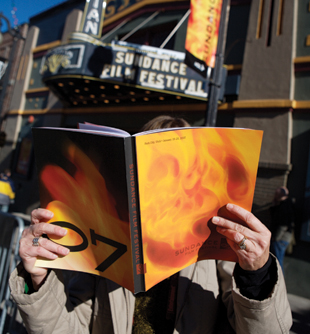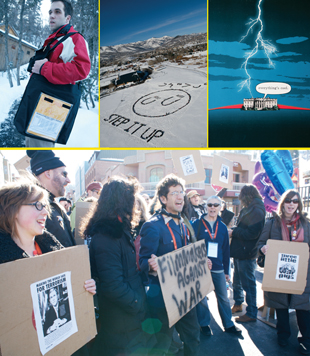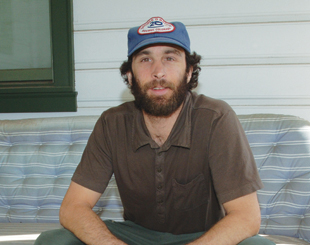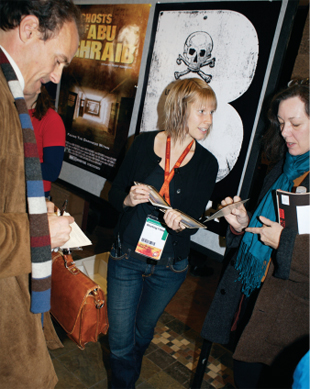

Photos by Chris Pilaro
Everything's Cool at Sundance
Hailey resident and
Sun Valley Guide contributing photographer Chris Pilaro premiered
his documentary Everything’s Cool at this year’s Sundance Film Festival.
The venue turned into an ideal setting for a call to action on his
film’s subject: global warming. The following is his photographic
journal of the experience.
Text by Sabina Dana Plasse.
Chris Pilaro knows something. He knows that documentary film has the power to educate its audience, to present a unique angle on an issue, one often overlooked by the mass media.
In February of this year, Pilaro, a Hailey photographer and filmmaker, was invited to take that knowledge to Sundance, in the form of the premiere of his global-warming documentary
Everything’s Cool."Sundance has a reputation of turning unknown low-budget films into overnight sensations such as Morgan Spurlock’s Super Size Me and Born Into Brothels: Calcutta’s Red Light Kids by Ross Kauffman in 2004, as well as Stacy Peralta’s Dogtown and Z-Boys in 2001. My goal at Sundance was to get in front of people to deliver the message of Everything’s Cool with as much activism and outreach as possible."
Taking a comedic yet serious approach to this topical issue, Everything’s Cool follows a group of global-warming prophets who are actively fighting to change the American public’s perspective on how to lead an environmentally-friendly life.
From an eco movie star to a bio-diesel maven, from a Capitol Hill whistleblower to a pair of controversial eco bad boys, Everything’s Cool follows the lives of these global-warming players as they travel across the country spreading their urgent message. The film provides not only education on an issue that has finally oozed out from under the rug, but also a glimmer of hope that a united front for addressing global warming can happen before it’s too late.
Founded by actor Robert Redford in 1984, the Sundance Film Festival—held annually in Park City, Utah—is an internationally recognized showcase for cutting-edge independent filmmaking. In the arena of arts and entertainment, Sundance is more than just a household word; it’s a badge of honor, one that has given many filmmakers a serious career boost.

Clockwise from top left-"On the run: Every film
in the Sundance Film Festival gets screened before it enters the
festival route and receives its own run bag and handler. Everything’s
Cool got both very late in the game, as the film was finished in New
York City 19 hours before the first screening in Utah. This was very
stressful, and the fact that no one had screened the entire movie prior
to its first showing had us all on the edge of our seats. A vision in
white: This striking image, designed by Ute elder Lacy Harris and
orchestrated by SpectralQ productions (spectralq.com), was formed by
more than 1,000 Park City students and festival-goers. The spectacle was
in answer to a similar action held in the Arctic that read "Arctic
Warning." This action was the start of Step It Up 2007, a movement that
asks Congress to step it up and cut CO2 emissions by 80 percent by 2050.
Visit stepitup2007.org.
Laugh out loud: The Everything’s Cool film poster shows
President George W. Bush claiming "Everything’s cool!" from inside the
White House, as it gets struck by lightning. This poster always gets a
chuckle. Hear our cry: Left, Liz Cole, and center, Scott Beibin,
co-founders of Evil Twin Booking—a group that encourages activist
filmmakers to show, speak and share their work to help inspire change (eviltwinbooking.org)—organized
this rally for filmmakers who oppose the war in Iraq."

Chris Pilaro, the man behind the movie
While it celebrates all genres, the festival has a strong reputation as a platform for nonfiction films. Consequently, the documentary category carries stiff competition among a very distinguished class of filmmakers: those who dive head first into controversial subjects, resurfacing with a golden nugget of truth.
Everything’s Cool was accepted into the Independent Film Documentary category. The 16 films invited were world premieres and competed for the highly-coveted Jury and Audience awards.
Produced by Toxic Comedy Pictures, Everything’s Cool was Pilaro’s first producing credit. Working with fellow producers Daniel Gold, Judith Helfand and Adam Wolfensohn, the team spent more than four and a half years researching their message: Global warming is the most dangerous chasm ever to emerge between scientific understanding and political action.

There’s always time for activism
"Here, Working Film’s
Kristin Henry heads up the Community Engagement Campaign surrounding
Everything’s Cool, with the hope that individuals who see the film will
take direct action and make a difference in helping to stop climate
change. Although it’s too early to tell, this was one of our main goals
for being at Sundance and hopefully people will understand that our work
and their interest does not stop at Sundance."
The good news: America finally gets global warming; the chasm is slowly closing and the scientific debate is over. The bad news: the United States, the country that will determine the fate of the globe, must transform its fossil fuel-based economy very quickly.
Everything’s Cool
is both a prequel and a sequel to Al Gore’s An Inconvenient Truth.
"People brought it up at every Q&A," Pilaro said of audience sessions at
the festival. "In the time it took us to make Everything’s Cool, An
Inconvenient Truth was conceived, filmed, finished and won an Oscar,
while we were still talking about the message and the messengers who are
dealing with climate change.
"An Inconvenient Truth is actually featured in our film because it has had a real impact on the public perception surrounding global warming. Now, we have to do something concrete at the local and federal level to deal with the problem."
Contrary to certain beliefs, Pilaro’s Sundance experience was not filled with the expected late-night parties and celebrity hobnobbing. Instead, Toxic Comedy Pictures, in conjunction with Working Films—the activist arm of Helfand’s production company—used the festival as a platform to present an agenda for change. Through introducing a number of progressive outreach and activism events to the Sundance community, Pilaro and his team gave Everything’s Cool a life beyond the movie theater.
The characters of Everything’s Cool
Ross Gelbspan is a Pulitzer Prize-winning author and investigative journalist who has reported on the subject of climate change for 15 years. He has published two books and countless articles related to the issue.
Bill McKibben has spent his life researching and writing about the inevitability of global warming and is considered the poet laureate of global warming. He is celebrating the 10th printing of his acclaimed book, The End of Nature, which is the first popular book ever written on the subject. McKibben is also the founder of Step It Up 2007.
Bish Neuhauser was transformed into an eco-movie star and bio-diesel maven over the course of the making of Everything’s Cool. The film follows his step-by-step process and personal education in the making and using of bio-diesel. At present, he is working with the Salt Lake City and Park City public schools to help reduce their carbon footprint. Visit biodiesel.org.
Rick Piltz is the director of Climate Science Watch, a program of the Government Accountability Project in Washington, D.C. Initiated in 2005, Climate Science Watch uses investigation, communication and reform advocacy to hold public officials accountable for using climate science and related research with integrity. The goal is to translate research into effective action to meet the challenges posed by global climate change. Prior to this life, Piltz worked as a public servant in the office of the multi-agency program on climate and global environmental change, but ended that career in 2005 when he left in protest over the Bush White House’s manipulation of key climate-change research. Visit climatesciencewatch.org.
Heidi Cullen is The Weather Channel’s first climatologist with a global-warming beat. When she started at The Weather Channel three years ago, she had to pack her PhD into 30-second sound bites, but due to the onslaught of climate change related natural disasters in 2005 she was given her own 30-minute show, The Climate Code. Visit climate.weather.com/onair.html.
Michael Shellenberger and Ted Nordhaus are two thirty-something Berkeley, California-based eco-messiahs, otherwise known as the "Bad Boys of Environmentalism." They rise to the top of the green charts for levying a radical critique of the movement with the self-published essay The Death of Environmentalism. It challenges what has, until now, been the basis of almost all climate change messaging—the "I have a nightmare" speech of polar bears floating away on ice caps. Read it here: thebreakthrough.org.
